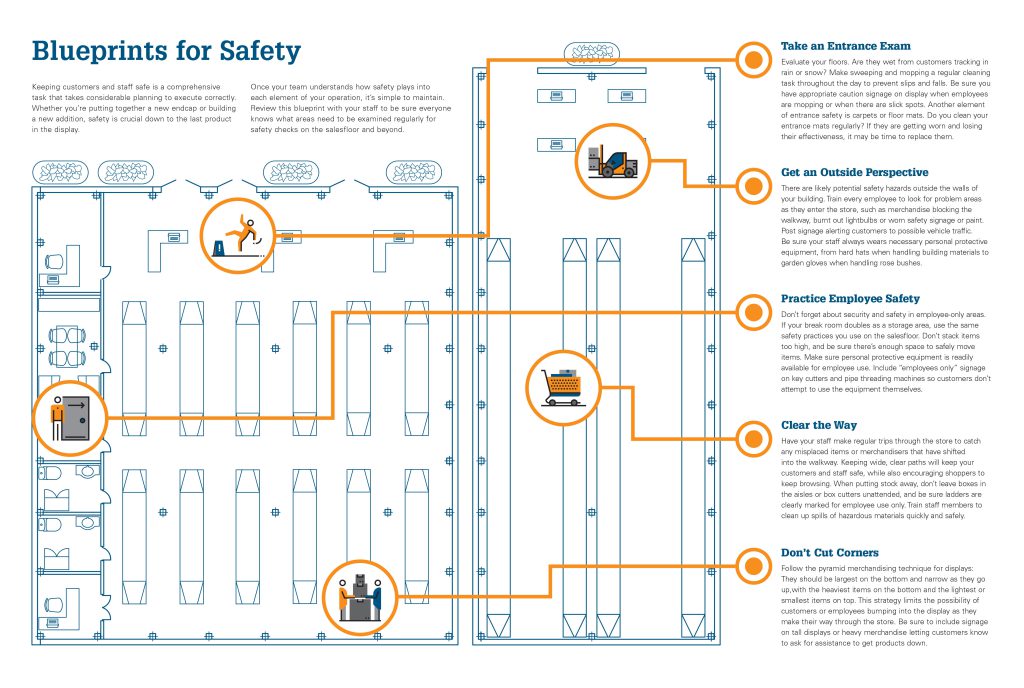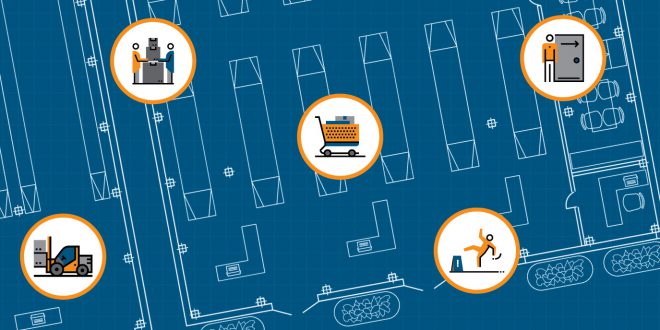A pyramid display of window cleaner at the end of an aisle can be an eye-catching reminder for customers who have been meaning to shine up their windows. But one stray jacket zipper catching the sprayer of a poorly built display can spell disaster, and not just because of the massive cleanup.
When it comes to safety in your operation, the details matter, and not only in your merchandising. While it’s important to train your employees how to build safe, effective displays, it’s also crucial that you provide the tools and information to keep your staff and customers safe in all areas of the store.
Safety also shouldn’t be an afterthought; when you’re designing a new power aisle, resetting your store or building an addition, you should incorporate safety into every decision. Keeping safety top of mind at every stage not only protects your customers and employees physically, but it also protects your business from liability.
To learn more about the intersection of safety and design, Hardware Retailing spoke to Gary Petz and Phil Mitchell, co-founders of the Discovery Retail Group, a consulting firm that specializes in retail operation budgeting, design and strategy.
Talking Safety With the Experts
 Gary Petz
Gary Petz
Partner and Co-Founder
Gary Petz has served many years in hardware and lumber operations. His experience allows him to help retailers focus on the customer experience. He is also the co-author of “10 Weeks to a Better Retail Operation” and he is an instructor for the North American Retail Hardware Association’s Retail Leadership Institute.
 Phil Mitchell
Phil Mitchell
Founding Partner
Phil Mitchell has developed unique ways to analyze the productivity of existing sales spaces and has designed many layouts in retail hardware operations. He is also the co-author of “10 Weeks to a Better Retail Operation.”
Hardware Retailing (HR): What are some key areas retailers should consider regarding safety while redesigning, resetting or building a new store?
Gary Petz (GP): There are some basic considerations. For example, aisle width is important to consider when it comes to the safety of a store. Aisles that are too narrow cause constriction and increase the likelihood of customers bumping into merchandise or other customers with their carts.
Gondola height is also a safety consideration. It is true that additional height allows more merchandise to be displayed, but it can also make shopping more challenging and possibly dangerous for shoppers who are shorter or who have disabilities.
The Americans with Disabilities Act has recommendations regarding minimum aisle width and other physical store considerations, like changes in floor elevations. Retailers should be familiar with those recommendations to ensure a safe shopping experience and work environment for everyone.
oBeyond safety, in the case of aisle width, aisles that are too narrow are not inviting and may even keep shoppers from entering the area because they feel too restricted.
HR: What are some areas retailers may overlook when it comes to safety?
Phil Mitchell (PM): We often see stores where endcaps have no base decks, only shelves acting as bases. Shelves protruding in this manner can cause shoppers turning the corners too sharply to trip or even cut their legs.
It’s also important to remember that aisle clutter—such as merchandise extending off the shelf or unpacked boxes on the floor—is extremely dangerous and should be avoided.
Wet and dirty floors should be cleaned quickly to prevent safety incidents. This problem is exacerbated in inclement weather when snow or rain may be tracked in. Retailers should use proper caution signage or placards when cleaning up spills or floors that are wet from the elements.
It’s also important for retailers not to forget that there are slight differences between employee safety and customer safety. For example, an employee might climb to an overhead display whereas a customer never should. However, injuries are injuries, and we want to prevent them from happening to anyone. A safe workplace for employees is a safe place for shoppers.
GP: Something as simple as pegboard hooks that are too long can cause injuries. Best practices suggest using a side counter with the same length hooks. Avoid merchandising sharp items on base decks and shelves that are too narrow. We once visited a store with aluminum roof jacks protruding beyond the base deck, which could have easily caused injury.
Another area of the store that operators may not think about in regard to safety are places customers may not go, such as break rooms and storage areas. Keeping backstock properly stored and giving employees easy access to safety equipment, such as ladders, hard hats and back support harnesses, is critical.
HR: Why is safety as a component of design, merchandising and store setup important?
GP: Safety is important in all of those areas because of the potential for injuries and resulting liability issues.
For example, merchandisers should be built in proportion to the size and weight of the products. Displays should feature heavy items on the base and move upward toward smaller and less bulky items.
HR: What are some resources retailers should consult when developing their safety plans?
GP: The Occupational Safety and Health Administration (OSHA) offers guidelines online. OSHA doesn’t provide resources specific to the hardware industry, but the recommendations for grocery retailers would be helpful for home improvement retailers to review.
The North American Retail Hardware Association (NRHA) partners with Member Insurance to give retailers access to industry-specific resources and services. (Learn more about this partnership here.)
PM: Retailers should check with their city, state and local municipalities for guidelines. Chambers of commerce or other local business organizations may also have resources available, especially for retailers who are considering building a new store or adding to an existing location.
Blueprints for Safety
Keeping customers and staff safe is a comprehensive task that takes considerable planning to execute correctly. Whether you’re putting together a new endcap or building a new addition, safety is crucial down to the last product in the display.
Once your team understands how safety plays into each element of your operation, it’s simple to maintain. Review this blueprint with your staff to be sure everyone knows what areas need to be examined regularly for safety checks on the salesfloor and beyond.
- Take an Entrance Exam
Evaluate your floors. Are they wet from customers tracking in rain or snow? Make sweeping and mopping a regular cleaning task throughout the day to prevent slips and falls. Be sure you have appropriate caution signage on display when employees are mopping or when there are slick spots. Another element of entrance safety is carpets or floor mats. Do you clean your entrance mats regularly? If they are getting worn and losing their effectiveness, it may be time to replace them. - Get an Outside Perspective
There are likely potential safety hazards outside the walls of your building. Train every employee to look for problem areas as they enter the store, such as merchandise blocking the walkway, burnt out lightbulbs or worn safety signage or paint. Post signage alerting customers to possible vehicle traffic. Be sure your staff always wears necessary personal protective equipment, from hard hats when handling building materials to garden gloves when handling rose bushes. - Practice Employee Safety
Don’t forget about security and safety in employee-only areas. If your break room doubles as a storage area, use the same safety practices you use on the salesfloor. Don’t stack items too high, and be sure there’s enough space to safely move items. Make sure personal protective equipment is readily available for employee use. Include “employees only” signage on key cutters and pipe threading machines so customers don’t attempt to use the equipment themselves. - Clear the Way
Have your staff make regular trips through the store to catch any misplaced items or merchandisers that have shifted into the walkway. Keeping wide, clear paths will keep your customers and staff safe, while also encouraging shoppers to keep browsing. When putting stock away, don’t leave boxes in the aisles or box cutters unattended, and be sure ladders are clearly marked for employee use only. Train staff members to clean up spills of hazardous materials quickly and safely. - Don’t Cut Corners
Follow the pyramid merchandising technique for displays: They should be largest on the bottom and narrow as they go up, with the heaviest items on the bottom and the lightest or smallest items on top. This strategy limits the possibility of customers or employees bumping into the display as they make their way through the store. Be sure to include signage on tall displays or heavy merchandise letting customers know to ask for assistance to get products down.
Click on the image for this print-friendly guide to share with your staff.

Click here for an inside look at managing safety best practices in the lumberyard, hear how Gillman Home Center general manager Jeff Sievers prioritizes safety with his team.
 Hardware Retailing The Industry's Source for Insights and Information
Hardware Retailing The Industry's Source for Insights and Information








